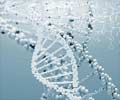Highlights
- CRISPR gene editing tool is used as a gene therapy for sickle cell anemia patients.
- The mutated gene was ‘corrected’ in the hematopoietic stem cells using the CRISPR tool.
- The treated cells were found to thrive after 16 days, paving the way for better treatment modalities for sickle cell anemia.
Sickle cell anemia is a group of inherited disorders that lead to a sickle shape of red blood cells which could block blood vessels, preventing transport of oxygen. The blocked arteries can lead to a painful situation called pain crisis and the damage to organs and tissues, over time. There is no treatment for this condition, but a new study by researchers from Stanford University has shown that the gene editing tool CRISPR could be used to treat people with sickle cell anemia. The gene editing tool was used to successfully result in normal hematopoietic stem cells and this was transplanted into mice. The team of researchers believe that this method could be used to treat different blood borne genetic disorders like sickle cell anemia and thalassemia.
Sickle Cell Anemia
This genetic condition is caused by a single gene mutation that leads to faulty hemoglobin molecules that are stiff and give the red blood cells a sickle shape. The red blood cells are normally flexible and go through blood vessels with relative ease. However, the stiff and faulty red blood cells in sickle cell patients could get lodged in the blood vessels and cause pain, along with poor oxygen-related damage to tissues.- 70,000 to 100,000 Americans are affected
- In Indian tribals, the incidence is between 1 to 40%
- In high-income countries, this condition is managed by treating symptoms and through blood transfusions.
- In low-income countries, sickle cell anemia leads to death before the age of 5 years.
Promise of Gene Therapy
Mathew Porteus, who is the senior author of the study and an associate professor of Pediatrics, said "What we've finally shown is that we can do it. It's not just on the chalkboard. We can take stem cells from a patient and correct the mutation and show that those stem cells turn into red blood cells that no longer make sickled hemoglobin."Professor Porteus and colleagues have been working on a gene therapy method of treatment for sickle cell anemia for many years, but they have been using an older gene editing tool. According to the professor, the older method took half a dozen years to carry out the alteration in the gene while CRISPR took less than a week and it worked much better than the earlier tool.
The CRISPR/Cas 9 system is a mechanism that is resent in bacteria to help it to prevent the growth of viruses. When the viral DNA enters the bacteria, the Cas 9 system is taken to the sequence complementary to the CRISPR sequence in the genome of the virus, cleaving the genome. The CRISPR sequence is generated from a previous exposure to the viral DNA. This defense mechanism has been adopted as a tool by scientists Jeniffer Doudna and colleagues to create a gene editing mechanism that cleaves target DNA and alters it.
Correcting the Mutation
Porteus and colleagues collected hematopoietic stem cells, cells that develop into blood cells, from sickle cell anemia patients and corrected the mutations using CRISPR. They concentrated these stem cells so that 90% of the cells were corrected to normal hematopoietic stem cells.- A patient does not show any symptom if the percentage of sickle cell red blood cells is below 30%.
- The life span of a sickle red blood cell is only 10 days while the life span of a normal red blood cell is 120 days.
- As the sickle cell red blood cells die soon and the normal cells live longer, the normal cells soon become more in number, with a reduction in the number of sickle cell red blood cells.
Some scientists believe that there could be unprecedented immune response due to the use of this technology or it could lead to unwanted mutations in regions of the genome, where the sequence could be similar but not exact. However, latest studies have shown that naturally occurring proteins could turn off CRISPR, allowing mutations only in regions of the genes that are dictated. This will help in regulating this gene editing tool and safeguard it from causing unnecessary mutations.
References:
- What Is Sickle Cell Disease? - (https://www.nhlbi.nih.gov/health/health-topics/topics/sca)
- Sickle cell disease in India: A perspective - (https://www.ncbi.nlm.nih.gov/pmc/articles/PMC4822363/)
- Sickle cell disease in tribal populations in India - (https://www.ncbi.nlm.nih.gov/pmc/articles/PMC4510747/)















